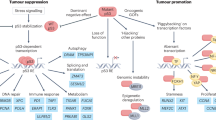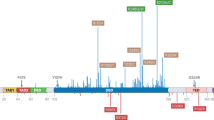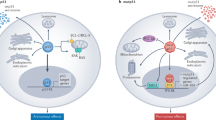Abstract
Missense mutations in p53 generate aberrant proteins with abrogated tumour suppressor functions that can also acquire oncogenic gain-of-function activities that promote malignant progression, invasion, metastasis and chemoresistance1,2,3,4,5. Mutant p53 (mutp53) proteins undergo massive constitutive stabilization specifically in tumours, which is the key requisite for the acquisition of gain-of-functions activities6,7,8. Although currently 11 million patients worldwide live with tumours expressing highly stabilized mutp53, it is unknown whether mutp53 is a therapeutic target in vivo. Here we use a novel mutp53 mouse model expressing an inactivatable R248Q hotspot mutation (floxQ) to show that tumours depend on sustained mutp53 expression. Upon tamoxifen-induced mutp53 ablation, allotransplanted and autochthonous tumours curb their growth, thus extending animal survival by 37%, and advanced tumours undergo apoptosis and tumour regression or stagnation. The HSP90/HDAC6 chaperone machinery, which is significantly upregulated in cancer compared with normal tissues, is a major determinant of mutp53 stabilization9,10,11,12. We show that long-term HSP90 inhibition significantly extends the survival of mutp53 Q/− (R248Q allele2) and H/H (R172H allele3) mice by 59% and 48%, respectively, but not their corresponding p53−/− littermates. This mutp53-dependent drug effect occurs in H/H mice treated with 17DMAG+SAHA and in H/H and Q/− mice treated with the potent Hsp90 inhibitor ganetespib. Notably, drug activity correlates with induction of mutp53 degradation, tumour apoptosis and prevention of T-cell lymphomagenesis. These proof-of-principle data identify mutp53 as an actionable cancer-specific drug target.
This is a preview of subscription content, access via your institution
Access options
Subscribe to this journal
Receive 51 print issues and online access
$199.00 per year
only $3.90 per issue
Buy this article
- Purchase on Springer Link
- Instant access to full article PDF
Prices may be subject to local taxes which are calculated during checkout




Similar content being viewed by others
References
Doyle, B. et al. p53 mutation and loss have different effects on tumourigenesis in a novel mouse model of pleomorphic rhabdomyosarcoma. J. Pathol. 222, 129–137 (2010)
Hanel, W. et al. Two hot spot mutant p53 mouse models display differential gain of function in tumorigenesis. Cell Death Differ. 20, 898–909 (2013)
Lang, G. A. et al. Gain of function of a p53 hot spot mutation in a mouse model of Li-Fraumeni syndrome. Cell 119, 861–872 (2004)
Morton, J. P. et al. Mutant p53 drives metastasis and overcomes growth arrest/senescence in pancreatic cancer. Proc. Natl Acad. Sci. USA 107, 246–251 (2010)
Olive, K. P. et al. Mutant p53 gain of function in two mouse models of Li-Fraumeni syndrome. Cell 119, 847–860 (2004)
Brosh, R. & Rotter, V. When mutants gain new powers: news from the mutant p53 field. Nature Rev. Cancer 9, 701–713 (2009)
Terzian, T. et al. The inherent instability of mutant p53 is alleviated by Mdm2 or p16INK4a loss. Genes Dev. 22, 1337–1344 (2008)
Suh, Y. A. et al. Multiple stress signals activate mutant p53 in vivo. Cancer Res. 71, 7168–7175 (2011)
Blagosklonny, M. V., Toretsky, J., Bohen, S. & Neckers, L. Mutant conformation of p53 translated in vitro or in vivo requires functional HSP90. Proc. Natl Acad. Sci. USA 93, 8379–8383 (1996)
Whitesell, L., Sutphin, P. D., Pulcini, E. J., Martinez, J. D. & Cook, P. H. The physical association of multiple molecular chaperone proteins with mutant p53 is altered by geldanamycin, an hsp90-binding agent. Mol. Cell. Biol. 18, 1517–1524 (1998)
Li, D., Marchenko, N. D. & Moll, U. M. SAHA shows preferential cytotoxicity in mutant p53 cancer cells by destabilizing mutant p53 through inhibition of the HDAC6-Hsp90 chaperone axis. Cell Death Differ. 18, 1904–1913 (2011)
Li, D. et al. Functional inactivation of endogenous MDM2 and CHIP by HSP90 causes aberrant stabilization of mutant p53 in human cancer cells. Mol. Cancer Res. 9, 577–588 (2011)
Bougeard, G. et al. Molecular basis of the Li-Fraumeni syndrome: an update from the French LFS families. J. Med. Genet. 45, 535–538 (2008)
Zerdoumi, Y. et al. Drastic effect of germline TP53 missense mutations in Li-Fraumeni patients. Hum. Mutat. 34, 453–461 (2013)
Muller, P. A. & Vousden, K. H. Mutant p53 in cancer: new functions and therapeutic opportunities. Cancer Cell 25, 304–317 (2014)
Weissmueller, S. et al. Mutant p53 drives pancreatic cancer metastasis through cell-autonomous PDGF receptor beta signaling. Cell 157, 382–394 (2014)
Trepel, J., Mollapour, M., Giaccone, G. & Neckers, L. Targeting the dynamic HSP90 complex in cancer. Nature Rev. Cancer 10, 537–549 (2010)
Whitesell, L. & Lindquist, S. L. HSP90 and the chaperoning of cancer. Nature Rev. Cancer 5, 761–772 (2005)
Dai, C., Whitesell, L., Rogers, A. B. & Lindquist, S. Heat shock factor 1 is a powerful multifaceted modifier of carcinogenesis. Cell 130, 1005–1018 (2007)
Min, J. N., Huang, L., Zimonjic, D. B., Moskophidis, D. & Mivechi, N. F. Selective suppression of lymphomas by functional loss of Hsf1 in a p53-deficient mouse model for spontaneous tumors. Oncogene 26, 5086–5097 (2007)
Slingerland, M., Guchelaar, H. J. & Gelderblom, H. Histone deacetylase inhibitors: an overview of the clinical studies in solid tumors. Anticancer Drugs 25, 140–149 (2014)
Zou, J., Guo, Y., Guettouche, T., Smith, D. F. & Voellmy, R. Repression of heat shock transcription factor HSF1 activation by HSP90 (HSP90 complex) that forms a stress-sensitive complex with HSF1. Cell 94, 471–480 (1998)
Barretina, J. et al. The Cancer Cell Line Encyclopedia enables predictive modelling of anticancer drug sensitivity. Nature 483, 603–607 (2012)
Siegel, D., Yan, C. & Ross, D. NAD(P)H:quinone oxidoreductase 1 (NQO1) in the sensitivity and resistance to antitumor quinones. Biochem. Pharmacol. 83, 1033–1040 (2012)
Proia, D. A. & Bates, R. C. Ganetespib and HSP90: translating preclinical hypotheses into clinical promise. Cancer Res. 74, 1294–1300 (2014)
Socinski, M. A. et al. A multicenter phase II study of ganetespib monotherapy in patients with genotypically defined advanced non-small cell lung cancer. Clin. Cancer Res. 19, 3068–3077 (2013)
Harvey, M. et al. Genetic background alters the spectrum of tumors that develop in p53-deficient mice. FASEB J. 7, 938–943 (1993)
Jacks, T. et al. Tumor spectrum analysis in p53-mutant mice. Curr. Biol. 4, 1–7 (1994)
Landmann, H. et al. UDP glucuronosyltransferase 1A expression levels determine the response of colorectal cancer cells to the heat shock protein 90 inhibitor ganetespib. Cell Death Dis. 5, e1411 (2014)
Khoo, K. H., Verma, C. S. & Lane, D. P. Drugging the p53 pathway: understanding the route to clinical efficacy. Nature Rev. Drug Discov. 13, 217–236 (2014)
Ventura, A. et al. Restoration of p53 function leads to tumour regression in vivo. Nature 445, 661–665 (2007)
Dobbelstein, M. & Moll, U. Targeting tumour-supportive cellular machineries in anticancer drug development. Nature Rev. Drug Discov. 13, 179–196 (2014)
Gorska, M. et al. Geldanamycin and its derivatives as Hsp90 inhibitors. Front. Biosci. 17, 2269–2277 (2012)
Hrzenjak, A. et al. Histone deacetylase inhibitor vorinostat suppresses the growth of uterine sarcomas in vitro and in vivo. Mol. Cancer 9, 49 (2010)
Proia, D. A. et al. Multifaceted intervention by the Hsp90 inhibitor ganetespib (STA-9090) in cancer cells with activated JAK/STAT signaling. PLoS ONE 6, e18552 (2011)
Ying, W. et al. Ganetespib, a unique triazolone-containing Hsp90 inhibitor, exhibits potent antitumor activity and a superior safety profile for cancer therapy. Mol. Cancer Ther. 11, 475–484 (2012)
Acknowledgements
We are grateful to S. Schlick, D. Mott and P. Yang for technical assistance. This work was supported by National Cancer Institute award 1RO1CA176647 and Deutsche Forschungsgemeinschaft award MO 1998/2-1.
Author information
Authors and Affiliations
Contributions
U.M.M. conceived and designed the study, E.M.A., A.R.Y., D.L., S.X., R.S. and D.A.P. conducted experiments, E.M.A., A.R.Y., D.L. and M.D. analysed experiments, GL provided p53H/H and p53−/− cohorts, D.A.P. provided ganetespib and U.M.M. wrote the manuscript.
Corresponding author
Ethics declarations
Competing interests
Competing Interests: D.A.P. is employed by Synta Pharmaceuticals, a company that studies ganetespib, one of the drugs used in this paper.
Extended data figures and tables
Extended Data Figure 1 Generation and characterization of the conditionally inactivatable p53 flox R248Q allele.
a, Mouse exons 4–9 were replaced with human exons 4–9 (called HUPKI) containing a p53 R248Q mutation in exon 7 (marked by a star). Exons 2–10 were flanked with loxP sites in introns 1 and 10 (red arrows) to allow for Cre-targeted removal of the mutp53 allele upon addition of tamoxifen/4OHT. A deletable Neo selection box was flanked by FRT sites (green). Knock-in mice were mated with FLP mice to delete the Neo cassette in vivo, leaving behind the distal loxP site. The ‘floxQ’ allele thus has two loxP sites for subsequent Cre deletion. b, For genotyping, the Neo-deleted floxQ knock-in allele produces a 657-base-pair amplicon, in contrast to the 490-base-pair amplicon derived from the wtp53 allele. c, Normal mouse embryo fibroblasts (MEFs) from floxQ/− embryos, which as non-malignant cells express non-stabilized mutp53, were adenovirally infected with empty vector (−Cre) or Cre-expressing vector (+Cre). Cre-mediated deletion of the mutp53 allele was confirmed by immunoblot analysis. d, The floxQ and constitutive Q (‘Q’) alleles behave identically in all aspects of gain-of-function including overall survival and tumour spectrum (not shown). Both floxQ and Q mice predominantly develop aggressive T-lymphomas, with some additional B-lymphomas and sarcomas. Also, the RosaCreERT2 allele has no discernable impact (data not shown). Kaplan–Meier analysis comparing overall survival of floxQ/− (red), Q/− (blue) and p53−/− (black) mice. Significance was assessed by log rank and Wilcoxon tests. e, Deletion of the mutp53 allele induces cell death in vitro. Viability of primary T- lymphoma cells freshly harvested from floxQ/−;ERT2/+ mice (n = 4) and Q/−;ERT2/+ control mice (n = 3), untreated or treated once with 4OHT or vehicle (EtOH) in short-term culture for 3–6 days. CellTiter-Blue (CTB) assay, unpaired two-tailed Student’s t-test; mean ± s.e.m.; n, number of independent T-lymphomas. Bottom, corresponding immunoblots of representative T-lymphomas at day 6. f, Deletion of mutp53 improves survival of host mice. Therapeutic protocol with primary floxQ/− T-lymphomas allotransplanted (black arrow on time axis) via subcutaneous injections into SCID mice. After visible tumours appeared, SCID mice were treated with daily intraperitoneal injections of oil or tamoxifen (star on time axis). Mice were killed when allowable endpoint size (1.5 cm3) was reached. Kaplan–Meier analysis, log rank test. Tamoxifen-induced allele deletion was strong but incomplete, shown by representative p53 immunofluorescence staining of tumours at endpoint (4′,6-diamidino-2-phenylindole (DAPI) counterstain). g, Initial tumour volumes measured before treatment was started in the therapeutic protocol of the various groups shown in Fig. 1c. Unpaired two-tailed Student’s t-test; mean ± s.e.m.; n, number of allografts. h, Control for Fig. 1d. Therapeutic treatment of nude mice allografted with p53−/−;ERT2/+ T-lymphoma cells and treated with tamoxifen (150 mg per kg for 7 days) as indicated in the scheme in Fig. 1c (endpoint 2). No response to tamoxifen. Time course, initial allograft volume and tumour mass at endpoint. Unpaired two-tailed Student’s t-test; mean ± s.e.m.; n, number of allografts; NS, not significant.
Extended Data Figure 2 Mutp53 ablation in floxQ/− mice causes autochthonous tumour regression or stagnation and extends T-lymphoma-specific survival.
a, Time course of imaged tumours, normalized to their initial tumour size (same as Fig. 2a but zoomed into the first 12 days of treatment). Stagnation or regression of floxQ/−;ERT2/+ tumours treated with tamoxifen, in contrast to treated control tumours (floxQ/−;ERT2/+ on oil and Q/−;ERT2/+ on tamoxifen) which grow robustly. Symbol #, sarcomas; all others are T-lymphomas. b, Similar mitotic index supports the idea that cell cycle arrest and senescence are not significantly affected upon genetic mutp53 ablation in autochthonous T-lymphomas (from Fig. 2a–c) and subcutaneous allografts (from Fig. 1c, d). Instead, apoptosis is the main mechanism of tumour regression/stagnation. Quantification of phospho-S28 histone H3 (pH3)-positive cells in individual autochthonous tumours or allografts. Five (left) or three (right) random ×40 high-power fields (with no or only minimal apoptosis) were counted for each tumour. Mean ± s.d. are plotted. Representative pH3 immunostainings are shown. c–e, Kaplan–Meier analyses and log rank statistics comparing tamoxifen-treated T-lymphoma-specific survival (c, e) and overall (d) survival of floxQ/−;ERT2/+ mice versus constitutive Q/−;ERT2/+ and p53−/−;ERT2/+ control mice from Fig. 2g. Animals were treated once (arrow) at 10 weeks with oil or tamoxifen by intraperitoneal injections for 5 consecutive days. f, At endpoint (death), like T-lymphomas (Fig. 2h), most sarcomas in tamoxifen-treated floxQ/−;ERT2/+ mice are also entirely composed of p53-positive cells. This indicates strong selective pressure for mutp53-positive tumour cells in that the small minority of non-recombined malignant cells outcompeted the vast majority of recombined mutp53-deleted cells and with time took over the tumour mass, supporting tumour addiction to high levels of mutp53. Out of ten sarcomas, nine (90%) stained positive for p53 and only one (10%) was negative for p53. Immunostainings for p53 of representative fibro- and angiosarcomas are shown. Note, the blue cells in oil-treated osteosarcoma are normal stromal cells.
Extended Data Figure 3 Synergistic action of 17AAG+SAHA in subcutaneous xenografts of mutp53-harbouring T47D (p53 L194F) human breast cancer cells.
Representative images of nude mice and their dissected tumours with one Mio cell injected per site.
Extended Data Figure 4 Ganetespib kills mutp53 human and mouse cells in a mutp53-dependent manner.
a–c, On a molar basis, ganetespib is >50-fold more potent than 17AAG in degrading mutp53 and killing human mutp53 cancer cells. MDA468 (p53R280K) (a) and T47D (p53L194F) (c) breast cancer cells, as well as ES2 (p53S241F) ovarian cancer cells (b), were seeded into six-well plates and treated for 24–48 h. After incubation, dead cells were washed off and total protein lysates from only live cells were immunoblotted as indicated. CTB assays on parallel cultures for cell viability show drug activity. c, SKBR3, (p53R175H) breast cancer cells; DU145, heterozygous (p53P223L/V274F) prostate cancer cells. Mean ± s.e.m. of four (b) or three (c) technical replicas, unpaired two-tailed Student’s t-test. p-Akt and p-Erk are also Hsp90 clients; cleaved PARP indicates activated apoptosis. d–f, Ganetespib destabilizes mutp53 but not wtp53 in cultured human ovarian carcinoma cells EFO21 (p53C124R) and HOC7 (p53C275F) (d), wtp53 COV434 and COLO704 (e) and in human non-small-cell lung cancer xenografts H1975 (p53R273H) (f). Nude mice bearing tumour xenografts (each lane is an independent tumour) were treated with a single bolus of DMSO or ganetespib (50 mg per kg intravenously), tumours were harvested at baseline (30 min), 48 h and 72 h and cells were lysed and immunoblotted as indicated (f). Chk1 and CDK1 are other Hsp90 clients; cleaved PARP indicates activated apoptosis. g, h, Ganetespib decreases stabilized mutp53 levels in live Q/− T-lymphoma cells within 24 h, associated with induction of apoptosis. Freshly isolated live Q/− T-lymphoma cells were treated with DMSO or 50 nM ganetespib for 24 h, followed by immunoblots as indicated, Hsp70 indicates drug activity, Hsc70 is the loading control (g), Death curves of freshly isolated Q/− and p53−/− T-lymphoma cells treated with DMSO or 50 nM ganetespib for the indicated times, CTB and trypan blue exclusion assays (h). All values are relative to DMSO treatment at the same time point. Mean ± s.e.m., unpaired two-tailed Student’s t-test, n = 4 independent isolates per genotype for every time point, *P < 0.05, **P < 0.01. i, j, Ganetespib suppresses growth of subcutaneous allografts of Q/− B-lymphoma. Prophylactic protocol; treatment days are indicated in red, tumour cell injection is marked by arrow, time course of allograft growth; n, number of allografts (i), Therapeutic protocol (same as in Fig. 4b) and tumour mass at endpoint (j). Mean ± s.e.m.; unpaired two-tailed Student’s t-test; n, number of allografts. k, Ganetespib yields synergistic anti-tumour effects in combination with cyclophosphamide. Subcutaneous allografts of Q/− and H/H T-lymphoma cells were treated once (arrow) with the indicated doses of ganetespib or cyclophosphamide alone or in combination. The mean ± s.e.m. allograft size for Q/− and H/H at the start of treatment was 274 ± 36 mm3 and 323 ± 44 mm3, respectively. Unpaired two-tailed Student’s t-test; n, number of allografts. Each single drug is compared with the combination. *P < 0.05, **P < 0.01. l, Comparison of ganetespib treatment of floxQ/− versus corresponding p53−/− control mice from Fig. 4g. The floxQ/− mice, which normally have a significantly shorter lifespan than p53-null littermates2 (median 139 days versus 195 days, respectively, see also Extended Data Fig. 1d) respond to ganetespib with significantly longer survival (right shift) and now resemble that of p53−/− mice. Kaplan–Meier analysis, log rank statistics. m, n, Ganetespib monotherapy once a week improves overall survival more efficiently than either genetic mutp53 ablation or 17DMAG+SAHA given five times a week. Comparison of Kaplan–Meier survival curves (log rank statistics) of tamoxifen-treated floxQ/− animals from Fig. 2g and ganetespib-treated floxQ/− animals from Fig. 4g (m). Note, on the basis of their phenotypic identity (see Extended Data Fig. 1d), floxQ/− mice were used in Fig. 4g in lieu of Q/− to ensure direct comparability with tamoxifen treatment. Comparison of Kaplan–Meier survival curves (log rank statistics) of 17DMAG+SAHA-treated H/H animals from Fig. 3c and ganetespib-treated H/H animals from Fig. 4f (n).
Supplementary information
Supplementary information
This file contains Supplementary Western blot images. (PDF 1351 kb)
Rights and permissions
About this article
Cite this article
Alexandrova, E., Yallowitz, A., Li, D. et al. Improving survival by exploiting tumour dependence on stabilized mutant p53 for treatment. Nature 523, 352–356 (2015). https://doi.org/10.1038/nature14430
Received:
Accepted:
Published:
Issue Date:
DOI: https://doi.org/10.1038/nature14430
This article is cited by
-
Translating p53-based therapies for cancer into the clinic
Nature Reviews Cancer (2024)
-
Targeting p53 gain-of-function activity in cancer therapy: a cautionary tale
Cell Death & Differentiation (2024)
-
Nanoreceptors promote mutant p53 protein degradation by mimicking selective autophagy receptors
Nature Nanotechnology (2024)
-
Mutant p53-ENTPD5 control of the calnexin/calreticulin cycle: a druggable target for inhibiting integrin-α5-driven metastasis
Journal of Experimental & Clinical Cancer Research (2023)
-
Dual roles of TRIM3 in colorectal cancer by retaining p53 in the cytoplasm to decrease its nuclear expression
Cell Death Discovery (2023)
Comments
By submitting a comment you agree to abide by our Terms and Community Guidelines. If you find something abusive or that does not comply with our terms or guidelines please flag it as inappropriate.



